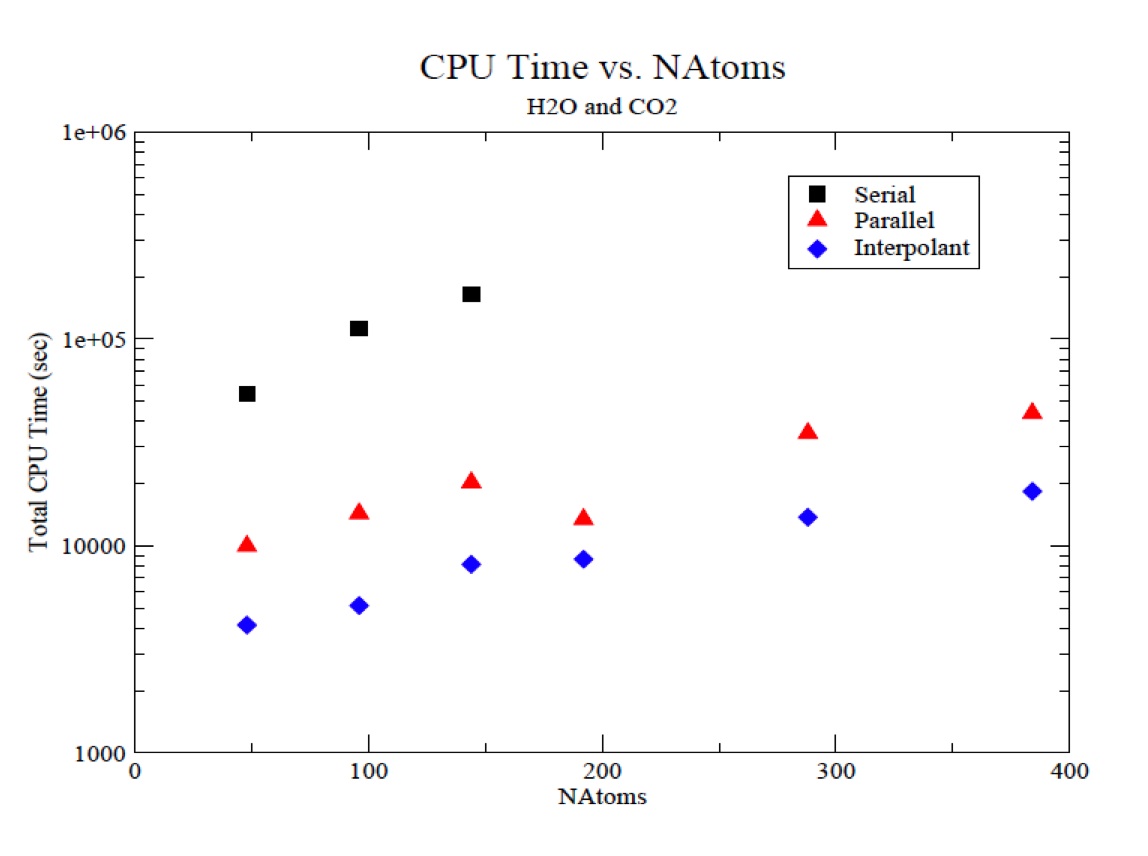www.acsprf.org
Reports: B647856-B6: The Development of Accelerated Molecular Dynamics for Complex Gas-Phase Reactive Systems
Michael R. Salazar , Union University
A suite of programs called Accelerated Molecular Dynamics with Chemistry (AMolDC) has been written, tested, and employed in order to perform adaptive, multilevel QM/MM simulations for complex chemical processes in the gas-phase. A paper that examines the properties of this new method was published recently.1 The method is formulated to give a time-dependent, multilevel representation of the total potential that is derived from spatially-resolved quantum mechanical (QM) regions. Ref. 1 shows that the AMolDC method scales linearly with system size due to the fact that at a constant temperature and pressure, the average system size will remain approximately constant regardless of the number of atoms in the simulation.
| Fig. 1 Computational scaling of AMolDC in serial, parallel, and with interpolation
|
 The last year of work has been centered on three
items: i.) examining different types of internal coordinates in which to
formulate the interpolant and programming the gradient conversion routines from
Cartesian to internals and vice versa ii.) writing a more robust version of AMolDC
that may submit the QM jobs in
serial or parallel and examining the computational scaling of AMolDC
in both serial and parallel, iii.) writing the interpolation module that will
use the saved grid of QM data for a given group to perform fast and accurate numerical
interpolations instead of another QM calculation. Each of these is examined in turn.
The last year of work has been centered on three
items: i.) examining different types of internal coordinates in which to
formulate the interpolant and programming the gradient conversion routines from
Cartesian to internals and vice versa ii.) writing a more robust version of AMolDC
that may submit the QM jobs in
serial or parallel and examining the computational scaling of AMolDC
in both serial and parallel, iii.) writing the interpolation module that will
use the saved grid of QM data for a given group to perform fast and accurate numerical
interpolations instead of another QM calculation. Each of these is examined in turn.
| Fig. 2 Accuracy of the interpolation module for diverse chemical systems as a function of the density of the underlying QM grid. |
 Much time this year was consumed in examining
the optimum coordinate system to use to formulate the interpolation module for
arbitrary chemical systems. A set
of reduced redundant atom-pair ordered internal coordinates was found to give
the most accurate interpolations for both small and large chemical systems. In addition, all the gradient
transformation had to be programmed.
These transformations are analogous to the transformations of Ref. 2.
Much time this year was consumed in examining
the optimum coordinate system to use to formulate the interpolation module for
arbitrary chemical systems. A set
of reduced redundant atom-pair ordered internal coordinates was found to give
the most accurate interpolations for both small and large chemical systems. In addition, all the gradient
transformation had to be programmed.
These transformations are analogous to the transformations of Ref. 2.
Second, AMolDC was rewritten to submit the QM jobs in parallel and timing tests were performed. Shown in Figure 1 is a log-log plot of CPU time for various system sizes of H2O/CO2 clusters for serial, parallel, and parallel/interpolation. The parallel jobs were submitted over an 18 node cluster. Figure 1 shows the tremendous cost savings associated with performing interpolations over running serial jobs and parallel. Figure 1 also demonstrates that system sizes of multiple hundreds of atoms may be studied with total CPU times of about 3 hours while interpolating on DFT and HF gradient surfaces.
Lastly, much time has been spent on the optimization of the interpolation module in order to produce accurate and fast interpolations over diverse chemical systems and diverse QM grids of these systems. Shown in Figure 2 are numerical tests on the accuracy of the interpolation module for diverse chemical species (inorganic and organic saturated and unsaturated rings and chains). Figure 2 shows that the interpolation module is able to perform very accurate interpolations of the QM gradients of very large and diverse chemical systems.
Two papers are in progress that examines the accuracy of the interpolation module and the computational scaling of AMolDC. Much of the writing has been completed on the interpolation paper. These papers will be submitted together as back-to-back publications in the same issue.
References:
1. Guthrie, M.G.; Daigle, A.D; Salazar, M.R. J. Chem. Theory Comput., 2010, 6, 18.
2. Bakken V. and Helgaker T. J. Chem. Phys., 2002, 117, 9160.
